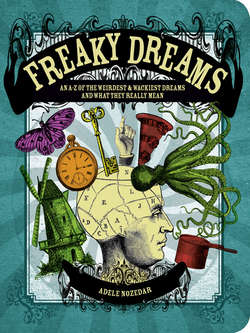Читать книгу Freaky Dreams - Adele Nozedar - Страница 5
HOW TO REMEMBER YOUR DREAMS
ОглавлениеThe dream is the small hidden door in the deepest and most intimate sanctum of the soul, which opens into that primeval cosmic night that was soul long before there was a conscious ego and will be soul far beyond what a conscious ego could ever reach.
-Carl Jung, The Meaning of Psychology for Modern Man, 1934
We’re presupposing that you already know how to sleep, so let’s get straight to the juicy stuff. Some of us really do believe that we never dream, or maybe that we dream only very rarely.
That’s not true. Everyone dreams.
What’s more, we each have several episodes of dreaming throughout the night. They occur primarily during the period of REM described above, during which our most intense dreams take place, but there’s also a phase called Non-Rapid Eye Movement (NREM) during which dreams might happen—or they might not..
So, if we all dream, then why don’t we all remember them?
Some scientists have speculated that we don’t remember them simply because it wouldn’t be healthy to do so. After all, if we had to think not only of all the stuff that happens every day in our waking lives AND then think about our dreams, we’d probably go mad. There also needs to be a clear distinction between dreams and waking reality. For example, to dream of flinging yourself from the top of a moving train and then finding that you can fly to safety is fine, but to try the same thing in real life wouldn’t be very clever. Dreams are by their very nature full of absurd scenarios and impossible situations which would simply never happen in our waking lives.
Always with the adjunct “Safety First,” then, here are some tips on how to remember your dreams.
DECIDE TO REMEMBER YOUR DREAMS
Start out by making the decision that you do actually want to be able to recall your dreams. Tell yourself that this is what you want. Repeat this mantra several times a day:
I will remember my dreams.
I will remember my dreams.
I will remember my dreams.
BREAK UP YOUR SLEEP PATTERN
If you can, aim to break up your sleep pattern. We remember our dreams usually when we’ve been woken up in the middle of, or immediately after, a dream episode.
You might have a dedicated friend who will time how long it take between you falling asleep until the REM pattern starts. You could try setting an alarm to wake yourself when this happens. Otherwise, try setting the alarm at random times. We sleep in 90-minute cycles, so if you don’t have to get up at the crack of dawn the next day, you could set an alarm clock to go off at 90-minute intervals throughout the night.
Other ways of breaking up your sleep pattern include eating indigestible food (see “Cheese Dreams” in CHEESE DREAMS: DOES FOOD MAKE FREAKY DREAMS…FREAKIER?), taking a long-haul flight into another time zone, or having a baby.
RECORD THE DREAM
The tried and tested method is to have a notebook and (working) pen or pencil beside the bed, but you might prefer to have a recording device. Remember, after all, that Keith Richards recorded “Satisfaction” in his sleep. Whatever means you decide to use, make sure they’re easily accessible and that you’re familiar with any technology. Dreams can be extraordinarily elusive and could easily escape by the time you’ve jabbed away at the paper with a succession of useless pens, or worked out which button to push.
REMIND YOURSELF OF WHAT YOU’RE DOING
It’s easy, befuddled with sleep, to forget what your aim is, especially if you’re trying the 90-minute alarm clock method. It’s all too simple to simply throw the clock across the room and continue snoozing. You might try placing a piece of card with the words “REMEMBER DREAM!” somewhere that you’ll see as soon as you wake up.
DON’T TRY TO ANALYZE ANYTHING
It’s more important that you get the details down without immediately worrying about the meaning of them. Let the dreams “be.” Let them breathe, live with them a little while before deconstructing them.
While you’re at it, you might want to consider using your dreams to solve problems.
You’ll see several examples dotted through this book about ingenious solutions that have been found in a dream, delivered to the dreamer as though on a silver platter. If you have any sort of conundrum, think of it several times during the day and then concentrate on it before you go beddy-byes. See what happens. By the way, you’re more likely to have pleasant dreams if you’re close to a pleasant scent, and vice versa.
A DISCLAIMER
Although the bulk of this book is an analysis of some of the features that might appear in your dreams, some of the freakiest dreams are simply beyond explanation, pure and simple. Don’t worry if this is the case with one of your dreams. Enjoy it, revel in it, have a laugh about it.
IN CONCLUSION
If you take all this into consideration and start to apply it, you’ll find that the more you remember your dreams, the easier it will get. It’s almost as though your subconscious mind, knowing that you’re extending the hand of friendship, starts to come out to play and communicate with you.
YOU MIGHT SEE PATTERNS EMERGING. YOU MIGHT DREAM OF AN INVENTION THAT MAKES YOU A MILLIONAIRE.
YOU MIGHT INVENT A PLOT THAT TURNS INTO A BEST-SELLING BOOK.
WHATEVER YOU DO, YOU’LL DEFINITELY HAVE FUN.
ENJOY YOUR FREAKY DREAMS!
